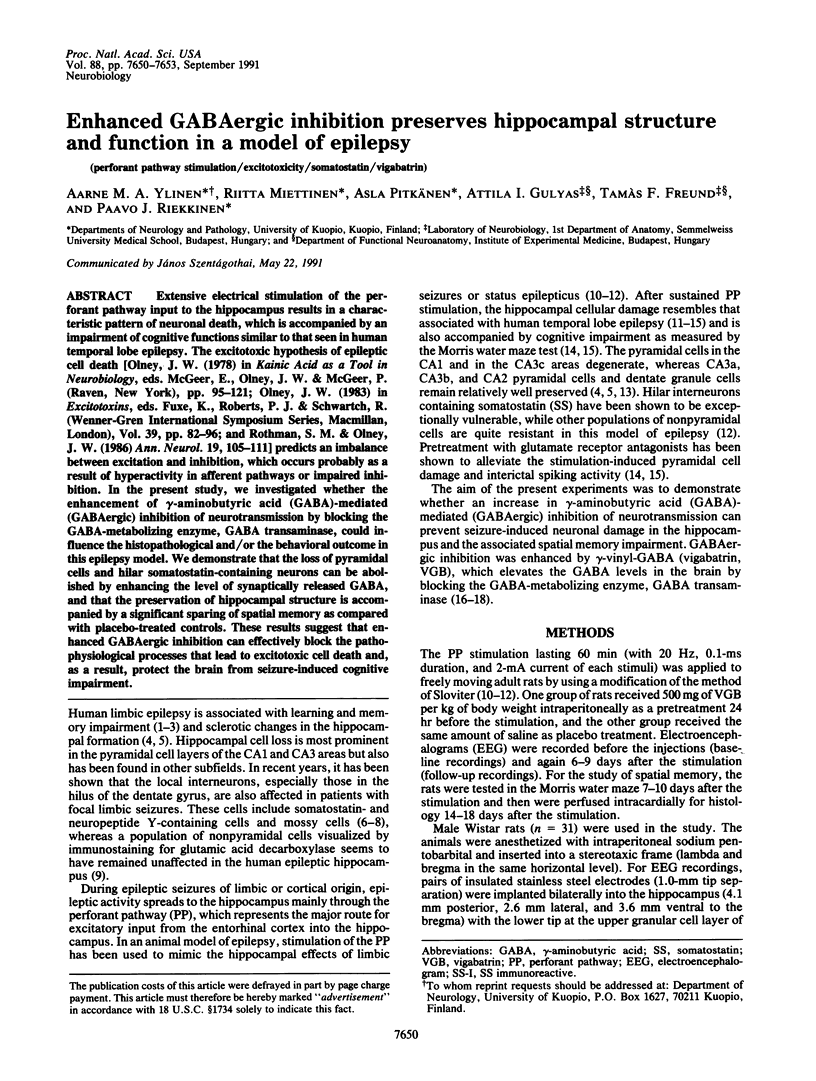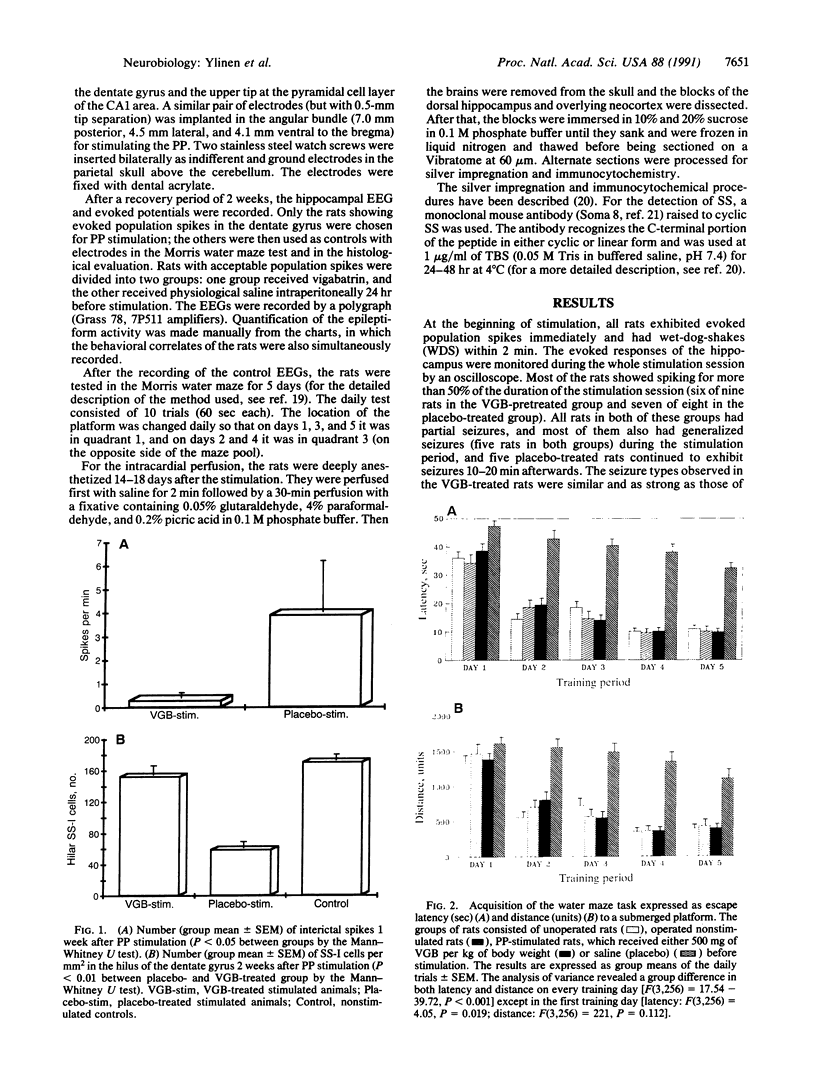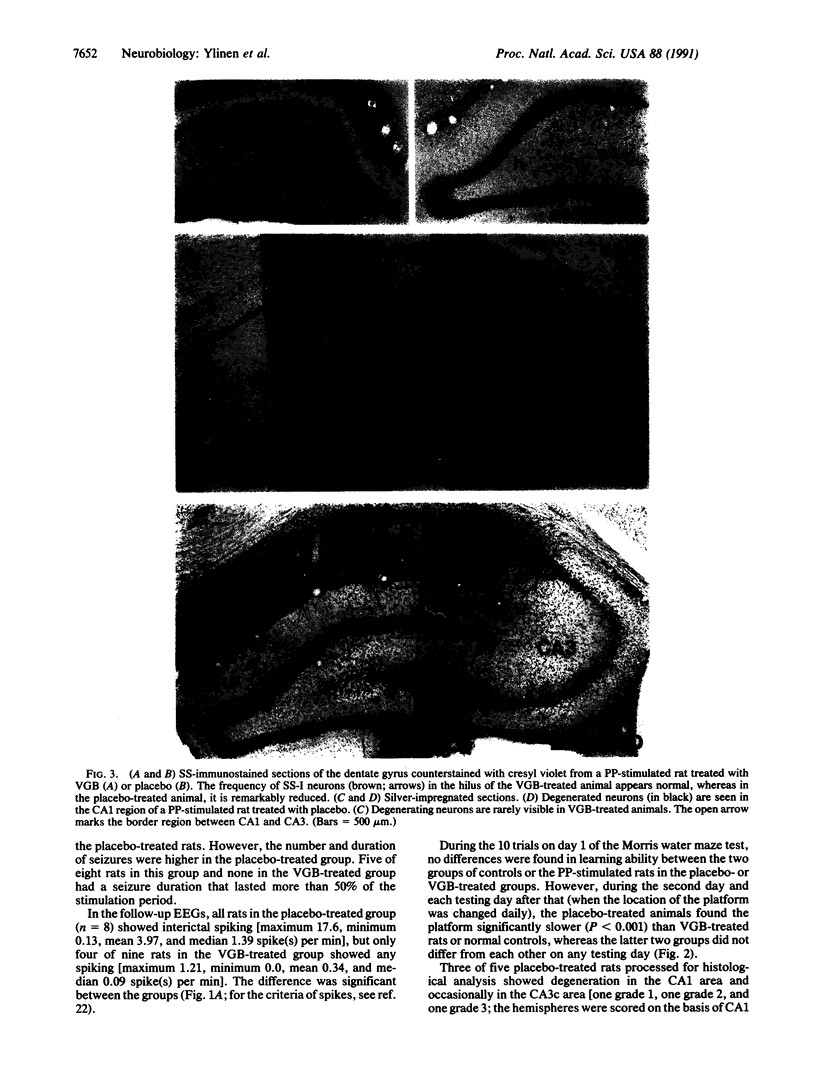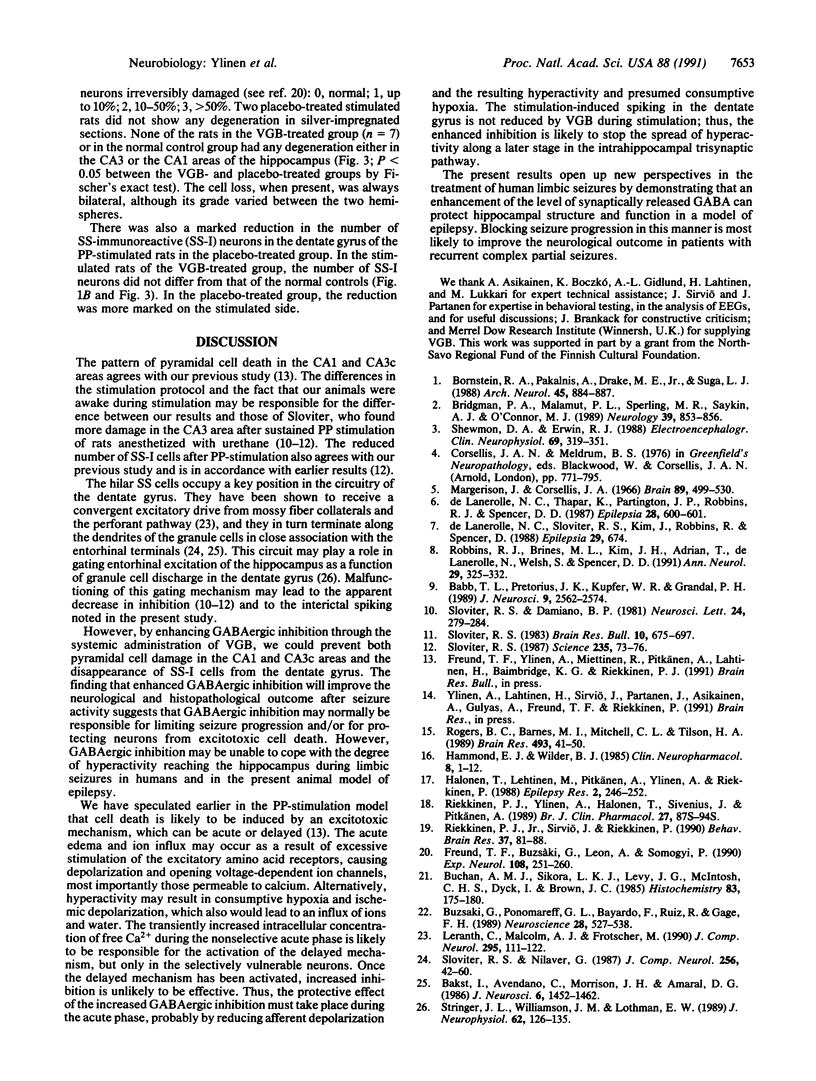Abstract
Extensive electrical stimulation of the perforant pathway input to the hippocampus results in a characteristic pattern of neuronal death, which is accompanied by an impairment of cognitive functions similar to that seen in human temporal lobe epilepsy. The excitotoxic hypothesis of epileptic cell death [Olney, J. W. (1978) in Kainic Acid as a Tool in Neurobiology, eds. McGeer, E., Olney, J. W. & McGeer, P. (Raven, New York), pp. 95-121; Olney, J. W. (1983) in Excitotoxins, eds. Fuxe, K., Roberts, P. J. & Schwartch, R. (Wenner-Gren International Symposium Series, Macmillan, London), Vol. 39, pp. 82-96; and Rothman, S. M. & Olney, J. W. (1986) Ann. Neurol. 19, 105-111] predicts an imbalance between excitation and inhibition, which occurs probably as a result of hyperactivity in afferent pathways or impaired inhibition. In the present study, we investigated whether the enhancement of gamma-aminobutyric acid (GABA)-mediated (GABAergic) inhibition of neurotransmission by blocking the GABA-metabolizing enzyme, GABA transaminase, could influence the histopathological and/or the behavioral outcome in this epilepsy model. We demonstrate that the loss of pyramidal cells and hilar somatostatin-containing neurons can be abolished by enhancing the level of synaptically released GABA, and that the preservation of hippocampal structure is accompanied by a significant sparing of spatial memory as compared with placebo-treated controls. These results suggest that enhanced GABAergic inhibition can effectively block the pathophysiological processes that lead to excitotoxic cell death and, as a result, protect the brain from seizure-induced cognitive impairment.
Full text
PDF



Images in this article
Selected References
These references are in PubMed. This may not be the complete list of references from this article.
- Babb T. L., Pretorius J. K., Kupfer W. R., Crandall P. H. Glutamate decarboxylase-immunoreactive neurons are preserved in human epileptic hippocampus. J Neurosci. 1989 Jul;9(7):2562–2574. doi: 10.1523/JNEUROSCI.09-07-02562.1989. [DOI] [PMC free article] [PubMed] [Google Scholar]
- Bakst I., Avendano C., Morrison J. H., Amaral D. G. An experimental analysis of the origins of somatostatin-like immunoreactivity in the dentate gyrus of the rat. J Neurosci. 1986 May;6(5):1452–1462. doi: 10.1523/JNEUROSCI.06-05-01452.1986. [DOI] [PMC free article] [PubMed] [Google Scholar]
- Bornstein R. A., Pakalnis A., Drake M. E., Jr, Suga L. J. Effects of seizure type and waveform abnormality on memory and attention. Arch Neurol. 1988 Aug;45(8):884–887. doi: 10.1001/archneur.1988.00520320074019. [DOI] [PubMed] [Google Scholar]
- Bridgman P. A., Malamut B. L., Sperling M. R., Saykin A. J., O'Connor M. J. Memory during subclinical hippocampal seizures. Neurology. 1989 Jun;39(6):853–856. doi: 10.1212/wnl.39.6.853. [DOI] [PubMed] [Google Scholar]
- Buchan A. M., Sikora L. K., Levy J. G., McIntosh C. H., Dyck I., Brown J. C. An immunocytochemical investigation with monoclonal antibodies to somatostatin. Histochemistry. 1985;83(2):175–180. doi: 10.1007/BF00495150. [DOI] [PubMed] [Google Scholar]
- Buzsáki G., Ponomareff G. L., Bayardo F., Ruiz R., Gage F. H. Neuronal activity in the subcortically denervated hippocampus: a chronic model for epilepsy. Neuroscience. 1989;28(3):527–538. doi: 10.1016/0306-4522(89)90002-x. [DOI] [PubMed] [Google Scholar]
- Freund T. F., Buzsaki G., Leon A., Somogyi P. Hippocampal cell death following ischemia: effects of brain temperature and anesthesia. Exp Neurol. 1990 Jun;108(3):251–260. doi: 10.1016/0014-4886(90)90131-b. [DOI] [PubMed] [Google Scholar]
- Halonen T., Lehtinen M., Pitkänen A., Ylinen A., Riekkinen P. J. Inhibitory and excitatory amino acids in CSF of patients suffering from complex partial seizures during chronic treatment with gamma-vinyl GABA (vigabatrin). Epilepsy Res. 1988 Jul-Aug;2(4):246–252. doi: 10.1016/0920-1211(88)90015-0. [DOI] [PubMed] [Google Scholar]
- Hammond E. J., Wilder B. J. Gamma-vinyl GABA: a new antiepileptic drug. Clin Neuropharmacol. 1985;8(1):1–12. doi: 10.1097/00002826-198503000-00001. [DOI] [PubMed] [Google Scholar]
- Leranth C., Malcolm A. J., Frotscher M. Afferent and efferent synaptic connections of somatostatin-immunoreactive neurons in the rat fascia dentata. J Comp Neurol. 1990 May 1;295(1):111–122. doi: 10.1002/cne.902950110. [DOI] [PubMed] [Google Scholar]
- Margerison J. H., Corsellis J. A. Epilepsy and the temporal lobes. A clinical, electroencephalographic and neuropathological study of the brain in epilepsy, with particular reference to the temporal lobes. Brain. 1966 Sep;89(3):499–530. doi: 10.1093/brain/89.3.499. [DOI] [PubMed] [Google Scholar]
- Riekkinen P. J., Ylinen A., Halonen T., Sivenius J., Pitkanen A. Cerebrospinal fluid GABA and seizure control with vigabatrin. Br J Clin Pharmacol. 1989;27 (Suppl 1):87S–94S. doi: 10.1111/j.1365-2125.1989.tb03467.x. [DOI] [PMC free article] [PubMed] [Google Scholar]
- Riekkinen P., Jr, Sirviö J., Riekkinen P. Similar memory impairments found in medial septal-vertical diagonal band of Broca and nucleus basalis lesioned rats: are memory defects induced by nucleus basalis lesions related to the degree of non-specific subcortical cell loss? Behav Brain Res. 1990 Feb 12;37(1):81–88. doi: 10.1016/0166-4328(90)90073-n. [DOI] [PubMed] [Google Scholar]
- Robbins R. J., Brines M. L., Kim J. H., Adrian T., de Lanerolle N., Welsh S., Spencer D. D. A selective loss of somatostatin in the hippocampus of patients with temporal lobe epilepsy. Ann Neurol. 1991 Mar;29(3):325–332. doi: 10.1002/ana.410290316. [DOI] [PubMed] [Google Scholar]
- Rogers B. C., Barnes M. I., Mitchell C. L., Tilson H. A. Functional deficits after sustained stimulation of the perforant path. Brain Res. 1989 Jul 24;493(1):41–50. doi: 10.1016/0006-8993(89)90998-0. [DOI] [PubMed] [Google Scholar]
- Shewmon D. A., Erwin R. J. The effect of focal interictal spikes on perception and reaction time. I. General considerations. Electroencephalogr Clin Neurophysiol. 1988 Apr;69(4):319–337. doi: 10.1016/0013-4694(88)90004-1. [DOI] [PubMed] [Google Scholar]
- Sloviter R. S. "Epileptic" brain damage in rats induced by sustained electrical stimulation of the perforant path. I. Acute electrophysiological and light microscopic studies. Brain Res Bull. 1983 May;10(5):675–697. doi: 10.1016/0361-9230(83)90037-0. [DOI] [PubMed] [Google Scholar]
- Sloviter R. S., Damiano B. P. Sustained electrical stimulation of the perforant path duplicates kainate-induced electrophysiological effects and hippocampal damage in rats. Neurosci Lett. 1981 Jul 17;24(3):279–284. doi: 10.1016/0304-3940(81)90171-3. [DOI] [PubMed] [Google Scholar]
- Sloviter R. S. Decreased hippocampal inhibition and a selective loss of interneurons in experimental epilepsy. Science. 1987 Jan 2;235(4784):73–76. doi: 10.1126/science.2879352. [DOI] [PubMed] [Google Scholar]
- Sloviter R. S., Nilaver G. Immunocytochemical localization of GABA-, cholecystokinin-, vasoactive intestinal polypeptide-, and somatostatin-like immunoreactivity in the area dentata and hippocampus of the rat. J Comp Neurol. 1987 Feb 1;256(1):42–60. doi: 10.1002/cne.902560105. [DOI] [PubMed] [Google Scholar]
- Stringer J. L., Williamson J. M., Lothman E. W. Induction of paroxysmal discharges in the dentate gyrus: frequency dependence and relationship to afterdischarge production. J Neurophysiol. 1989 Jul;62(1):126–135. doi: 10.1152/jn.1989.62.1.126. [DOI] [PubMed] [Google Scholar]







